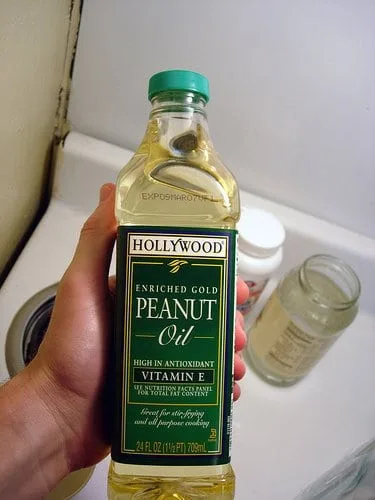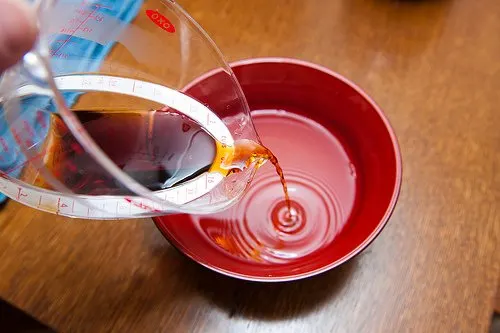Let’s talk about the shelf life, spoilage, and reusing peanut oil.
Say you bought a bottle to deep fry your Thanksgiving turkey, it’s been a couple of years later, and you still haven’t used that oil. Does peanut oil go bad, and if so, how do you tell?
Or maybe you’ve just opened a bottle of toasted peanut oil, and you’re wondering how long it is good for. How long does peanut oil last?
If either sounds familiar, this article is for you.
Let’s jump right in.
Image used under Creative Commons from Adam Engelhart
Table of Contents
- Does Peanut Oil Go Bad?
- How to Tell if Peanut Oil Is Bad?
- How Long Does Peanut Oil Last?
- How to Store Peanut Oil
- Reusing Peanut Oil
- Peanut Oil Shelf Life and Spoilage Summary
Does Peanut Oil Go Bad?
Sooner or later, peanut oil goes rancid, even if it sits unopened in a cool spot.
You can tell that yours has gone rancid if it tastes sharp or bitter, or gives off a putrid or chemical-like smell. The smell isn’t always easily discernible, but the flavor change is pretty apparent.
(The same is true for other oils, including canola, grapeseed, or sesame oil.)
The rancidification is a gradual process, so it’s not like the taste change happens overnight. Instead, it takes months until you can notice any difference.
That said, eating a bit of rancid peanut oil or using it in cooking won’t make you sick, at least not immediately. But if you consume it regularly, it could have some negative consequences, which is why I strongly suggest discarding rancid peanut oil.
Fortunately, the flavor change is usually enough for most people to toss the oil.
Having that out of the way, let’s talk about what to look for in peanut oil when checking if it’s still okay to eat.
How to Tell if Peanut Oil Is Bad?
Discard peanut oil if:
- The quality is pretty bad after a couple of uses. Some symptoms of overused oil include turning food greasy instead of crisp, foaming on the surface, lowered smoke point (i.e., smoking before the oil reaches its temperature), darkened color, and a “dirty” look.
- The oil smells off. If it smells like old paint or crayons, the oil is rancid. If it gives off a musty aroma after using it a few times, it has had enough, and you should get rid of it too. Any other smell that’s not normal also means the oil is done for. For reference, toasted peanut oil should smell nutty and toasty, cold pressed should have a slight peanut smell, and refined peanut oil shouldn’t smell like much.
- It tastes sharp or bitter. A noticeable change in taste is typical for rancid oil. Again, the toasted variety should taste toasty, cold pressed should have a mild peanut flavor, and refined should be pretty neutral.
- There’s anything in the bottle that shouldn’t be there. Before using the oil, check the bottle’s surface, bottom, and neck to ensure there aren’t any contaminants. It’s especially important if you’re ordering the oil online and not buying it in the grocery store. Also, filter the oil well before storing it for another round of deep frying.
Those are the most common signs of spoilage. But if you notice anything else about your peanut oil that’s weird or concerning, trust your intuition and get rid of the fat.
Next up, let’s talk about storage time.
Image used under Creative Commons from star5112
How Long Does Peanut Oil Last?
Peanut oil lasts about 2 years unopened and around 6 months after opening. Cold pressed or toasted peanut oil might have a slightly shorter storage time, while the refined variety might last longer, but the storage periods recommended by manufacturers are usually pretty similar for all varieties.
Furthermore, the mentioned storage period is only a conservative estimate, and if you store your peanut oil properly, chances are it’ll keep for much longer.
Next, remember that using your peanut oil shortens its shelf life significantly if you want to reuse it. So if you open a fresh bottle, use the oil once, and store all the leftover fat, it’s not a given that it’ll retain quality for the following six months.
Instead, if you’re not deep frying food that often, I suggest you line up a couple of deep frying sessions within a month or two of opening a fresh bottle. This way, you make the best of the oil you’ve got and discard it once you’re done. Or sooner, if that oil is no longer good enough to use.
(More about reusing oil later on.)
Now, let’s cover storage.
How to Store Peanut Oil
Store peanut oil sealed tightly and in a cool and dry place, away from sunlight and heat sources. If you want it to last as long as possible, or it’s an expensive bottle of roasted peanut oil, refrigerating it is worth considering.
Like all cooking oils, peanut oil deteriorates more quickly when exposed to air, light, and heat.
That’s why you should:
- remember to seal the bottle tightly after use to limit air exposure
- store it in a cabinet or cupboard away from sunlight
- keep the oil away from the stove and other places where the temperature fluctuates
If you decide to refrigerate peanut oil, remember that it might turn cloudy or crystallize (depending on the variety). That doesn’t make the oil bad, and you can easily reverse that effect by bringing the oil back to room temperature.
What’s important is that if you need that refrigerated oil to finish a salad or pour over roasted veggies, having it at room temperature and pourable would be quite helpful. That might mean pouring some into a bowl and leaving it at room temperature, so it warms up before use.
Finally, let’s talk about resuing peanut oil.
Reusing Peanut Oil
Peanut oil, especially its refined variety, is a popular deep frying oil thanks to its high smoke point (450°F or 232°C) and because it doesn’t absorb the flavor of foods cooked in it.
That makes it an excellent option for reusing, but unfortunately, that doesn’t mean that you’ll be able to reuse it indefinitely. At a certain point, the overall quality of the oil will be pretty bad, and you’ll need to replace it before another deep frying session.
How Long Does Used Peanut Oil Last?
It’s pretty much impossible to tell how long used peanut oil will last or how many times you can cook with it before discarding it. It’s not as cut-and-dried as any of us would’ve liked.
Instead, before and after every cooking session, you should quickly assess the quality of the oil and decide if it’s good enough to use. I covered how to go about that in the section on spoilage.
Besides that, it’s good to know what affects the quality of oil the most so that you can plan accordingly.
For starters, it’s what you’re frying. Plain vegetables have minimal impact on the oil, battered foods have a slightly larger one, while flour-dredged foods have the highest.
So if you want your peanut oil to last the longest, stick to frying veggies and battered stuff.
Another way to think about it is this: consider the size of food particles submerged in oil. Bare veggies are pretty large and don’t leave any debris behind, while a flour-coated fish leaves a ton of small ones difficult to filter out.
Next, it’s the cooking temperature. Don’t overheat the oil (a thermometer comes in handy here), and it’ll keep quality for much longer.
Finally, keep the oil in good shape while cooking. That means removing between batches any large particles, especially those that end up on the surface. A couple of swings with a fine mesh strainer should be enough.
For more info on reusing frying oil, read this article by Kenji Lopez-Alt. It dives much deeper into the topic.
Storing Used Peanut Oil
You store your used peanut oil the same way you store regular peanut oil: sealed tightly in a cool and dark place, away from heat sources. If you want to go the extra mile, refrigerate it.
Next, always store used peanut oil separately, and pour it into a bottle only after it has cooled a bit and you’ve filtered it using a sieve, a coffee filter, or a cheesecloth.
Peanut Oil Shelf Life and Spoilage Summary
Thanks for reading this primer on peanut oil. Here are the takeaways:
- Peanut oil goes rancid if stored in poor conditions or for too long. Yours is rancid if it tastes sharp or bitter or gives off a weird chemical-like smell. The aroma change isn’t always obvious, but the taste usually is.
- Peanut oil lasts about 2 years unopened and around half a year after opening. Roasted and cold-pressed varieties might not last quite as long, while refined peanut oil should keep for a bit longer, but the differences aren’t that big.
- Store peanut oil in a cool and dark place, sealed tightly. If it’s the cold-pressed or toasted variety and you want it to retain top quality for as long as possible, consider refrigeration.

